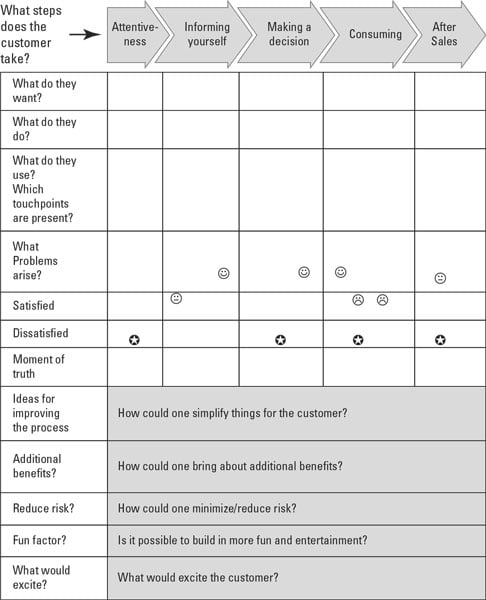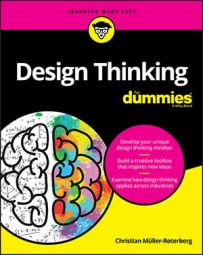Potential target persons might include
- Personae in a certain target segment
- First-time buyers
- Extreme users (who use products often or under special conditions)
- Nonbuyers
- Customers or users
- Decision makers in the buying process
- Influencers of the purchasing behavior
- Potential saboteurs during the sales process
 A customer journey for acquiring a hotel accommodation.
A customer journey for acquiring a hotel accommodation.Keep in mind that there can be different customer journeys, depending on the target person, or that different target persons can have individually distinct customer journeys. Create separate customer journeys for different people and compare them afterward. In many cases, it was only this step — creating separate customer journeys — that led me to find interesting differences.
Describing the phases of the customer journey
In the first phase, give a detailed description of how a customer becomes aware of a need, a problem, or an offer. Summarize how the customer gathers information about wishes, about a solution to a problem, or about an offer. Address how the customer compares one offer with another.Imagine that you were looking at the customer journey for a hotel accommodation. A person — let’s call him Fred from Hamburg — becomes aware of a Rolling Stones concert in Munich. He gets this information from an online ad on an information portal about rock music. Online, Fred gets information about the Stones appearance, about Munich, and about the possibilities of traveling to Munich and spending a night there. Excited about the prospect, he views hotel offers on a hotel comparison portal and initially compares them only superficially.
In the second phase of the customer journey, a decision is made. Examine how and by whom or through what the customer is positively or negatively influenced during his buying decision. You should also ask the basic question of why the customers make a selection.
Based on recommendations from friends, Fred is seriously considering only a few hotels in downtown Munich. He compares them in terms of the location and the price-performance ratio. A quiet location, good and inexpensive transport access, and a well-equipped fitness area in the hotel are important factors in Fred’s decision. He ultimately decides on a hotel based on the recommendation of a friend.In the fourth phase, explore everything that happens during the use of the product or service. Analyze what potential customers experience step-by-step when they use a service or product. You should describe this phase quite specifically and in some detail. Every step, every activity, every move, and every thought should be analyzed individually.
Fred travels to Munich and takes the subway to his hotel. Because he doesn’t find any signs for the hotel at the subway station, he wants to use his smartphone for navigation. The battery on his smartphone is dead, which means he has to ask pedestrians for directions. Mildly annoyed, Fred finally finds the hotel. No one is at the reception desk. A half-hour later, an unfriendly receptionist receives him. Fred wants to get dinner at the hotel before the concert. Because Fred is a vegetarian, his only choice is between potato salad and potato soup. The next morning, Fred goes to have breakfast at the hotel: pork fat with cracklings, beer cheese dip, and mashed potato spread with a fresh pretzel and a peasant loaf — not quite a “selection” to Fred’s taste. After being unable to pay with a credit card, Fred hastily leaves the hotel.The last phase, the after-sales phase, focuses on the customer’s activities after he has had some experiences with the product or service. Describe the customer’s needs, tasks, or expectations in the after-sales phase. The question of how and by whom or what means the customer can be motivated to make another purchase is of particular interest to you. You shouldn’t underestimate the fact that the customer will use word-of-mouth communication to share these experiences with the product or services. Check how and by whom or by what means the customer is persuaded to report a positive buying experience. Look at where (on the Internet, at home, or in the office) and on which occasions the customer will report about the experiences.
Fred has returned to Hamburg. First, he tells his friend who recommended the hotel in Munich to him all about his experiences in Munich. Although he has never reviewed products or services on the Internet, he talks extensively about his bad experiences with the hotel on the hotel comparison portal, which he also used to book the hotel. On the same day after submitting his review online, the hotel contacts him directly by email via the comparison portal. The hotel owner apologizes sincerely to Fred and invites him to a weekend in Munich, including a first-class trip by train.In each phase of the customer journey, ask yourself the following questions:
- What does the persona want here? What does it want to achieve?
- What does it do, or (surprisingly) what doesn’t it do? How does it try to achieve its goals or wishes?
- What does it use for this purpose, and in what order? With whom is the persona in contact? Where are the contact points — the touchpoints, in other words — with the company? How long does each of the contacts with the company last? How long are the individual customer journey phases in total?
The problems (and improvements) in the customer journey
The touchpoints are particularly important in the customer journey — these are places, occasions, or moments during which people come in contact with the product, brand, or company in the broadest sense. Touchpoints could be something in control of the company, such as advertisements, television or radio commercials, brochures, catalogs, flyers, trade fairs and events, customer hotlines, call centers, mailed items, personal advice, points of sale, store furnishings, an Internet presence, or online advertising (emails, newsletters, banners, e-shops, landing pages, and company/product blogs). Additionally, you have to take into account the touchpoints that can’t be influenced yet, or only indirectly, such as family members, acquaintances, friends of the target person, social media networks, reports in newspapers, magazines, forums, blogs, comparison websites, or rating portals.You should analyze each touchpoint with the following questions:
- Which touchpoints are particularly effective from the customer’s perspective — and which aren’t?
- To what degree does each touchpoint positively influence the customer experience?
- Are the possible touchpoints coordinated with each other throughout the customer journey?
- How do your own employees rate the individual touchpoints in terms of effort compared to benefit? Are there touchpoints that offer few customer benefits but are complex? Are there too many touchpoints that confuse the customer?
- Which touchpoints do your competitors have? Which ones do they not have? Why or why not?
- Are there enough touchpoints throughout the customer journey? Where are the gaps? Which additional contact points could be created for the customer?
- What can be automated, and how?
- The customer is annoyed.
- The customer is unpleasantly surprised by the price or costs.
- The customer doesn’t know what to do in a certain situation.
- The customer performs the activity incorrectly.
- The customer tries to solve the problem on their own.
- The customer has to wait and thus loses time.
- The customer performs unnecessary activities (waste).
- The customer is disappointed by the quality.
- The customer considers the situation or activity too complicated.
- The customer considers the situation or activity not user-friendly enough.
- The customer worries about risks or feels uncertain about the outcome.
- The customer is embarrassed in front of others.
Customer satisfaction is assessed for each phase and each step in a phase — a process that can be summarized in what is referred to as a customer experience map. How does the persona feel? (In working out the map, feel free to use simple symbols, such as various emojis.)
In addition, you can identify the key moments of truth for each phase or step. These are moments or situations that are particularly important for the customer. Different moments of truth are located along the customer journey:
- The first moment of truth: When the customer first becomes aware of the product or service
- The second moment of truth: When the customer is actually using the product or service and is evaluating the product or service based on the customer's quality standards of the moment
- The third moment of truth: When the customer has a positive, neutral, or negative feeling or experience after using the product or service
- The zero moment of truth (the moment of truth before starting): When the customer first perceives a problem or need through a suggestion or an impulse (such as advertising) and searches for or compares information about possible solutions
- The ultimate moment of truth: When the customer tells others about their experiences and feelings about the product or service (through social networks, review portals, or virtual communities, for example)
- Where can you simplify something for customers?
- How can you provide more benefits to your customers?
- Where can you reduce or minimize risks for your customers?
- Is it possible to integrate more fun and entertainment?
- What would inspire your customers?
 Analysis grid for the customer journey.
Analysis grid for the customer journey.You can use a variant of the customer journey when you outline a day in the life of a customer.
By dividing the journey into 15- or 30-minute blocks of time, for example, you can ask the following questions using the sample of a specific person:
- Where and how does the persona spend the day?
- Which products or services does it use?
- How much time does it spend using the product?
- How would the life of the persona change after it receives its product?
- How often is the persona online? Does it use a PC, laptop, tablet, or smartphone?
- Which devices does the customer use, when, and how often?
The customer journey, particularly the variant “a day in the life of the customer,” can be supplemented by not only a keyword description but also images, cartoons, and videos to visualize the information and make it more illustrative.

